Briefings / Global
Open season
Wondering where to eat this summer? Here we explore an impressive band of global openings and meet the roving restaurateurs behind them, including the Sydney cyclist peddling pies from the back of his bicycle and the Umbrian chef heading up a new venture from an Italian deli in London’s Soho.
That’s amari
Marcello
Singapore
Head bartender Palmira Bertuca oversees this intimate 50-seat Singapore bar that’s said to house Southeast Asia’s largest trove of amari: thick herbal Italian liqueurs that are usually consumed as an aperitif or digestivo. Let Bertuca talk you through the flavours of modern amari – which include ingredients such as cardamom, rhubarb and truffle – as you pick from Marcello’s list of Italian cocktails. They include the gin-based smoked black-olive Negroni and the blockbuster Cinema Paradiso, which comes garnished with a dainty cone of popcorn.
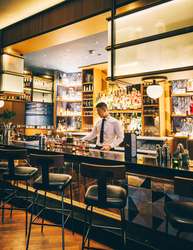
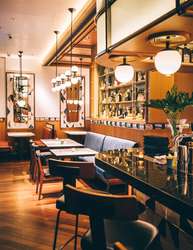

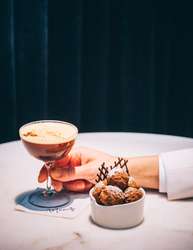
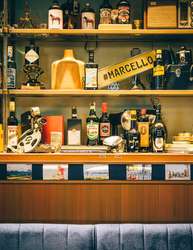


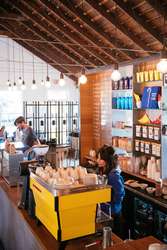
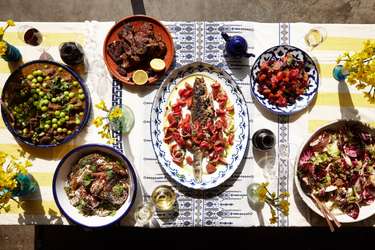
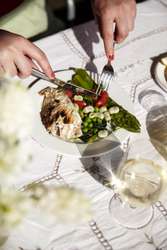
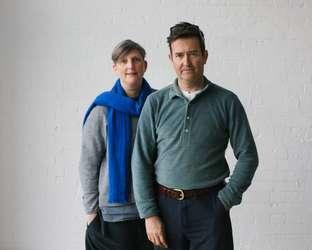
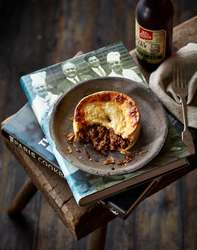
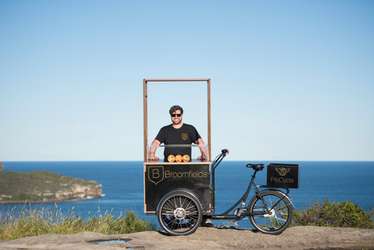
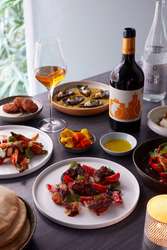

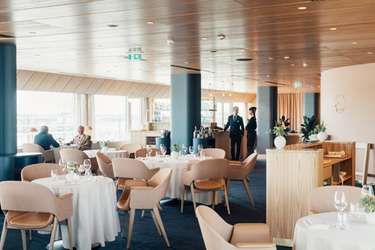
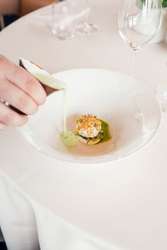
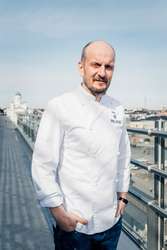
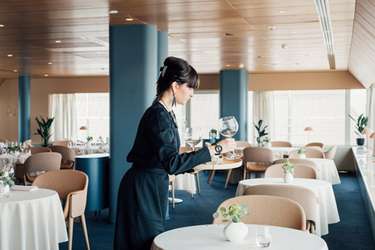
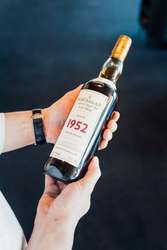
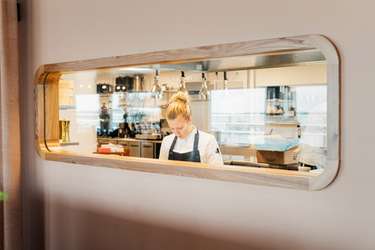

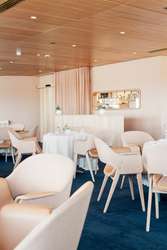
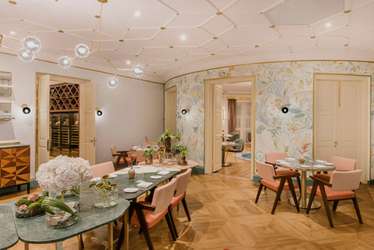





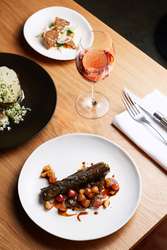
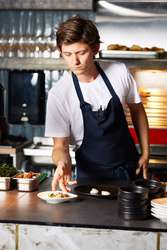

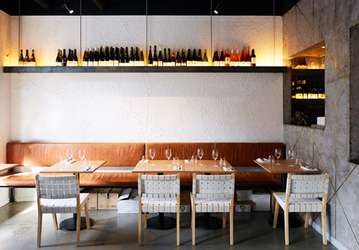
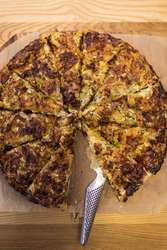
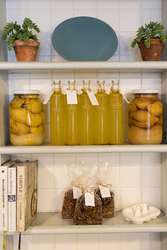
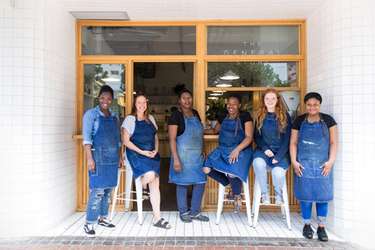


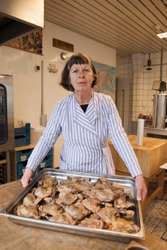

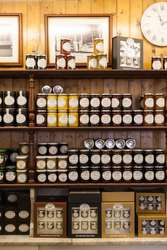
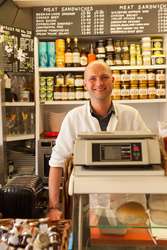
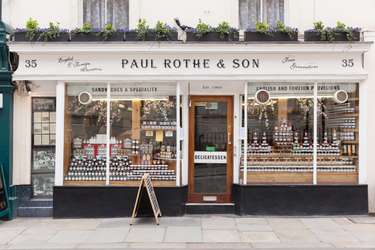
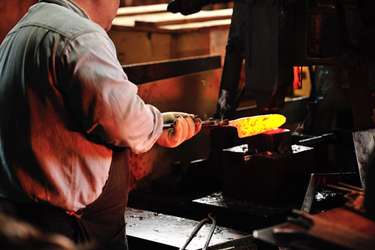

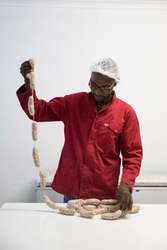
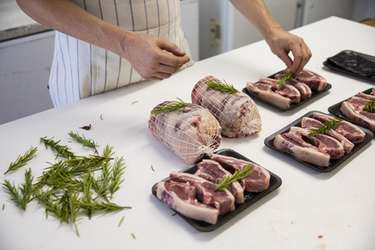
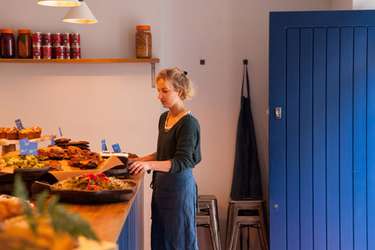

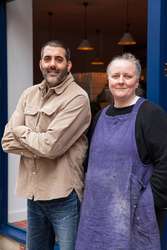
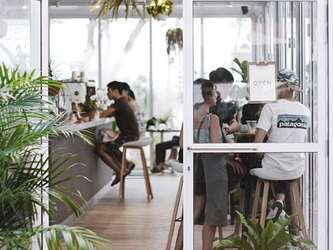
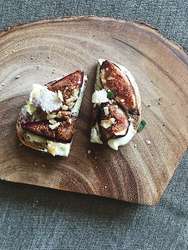
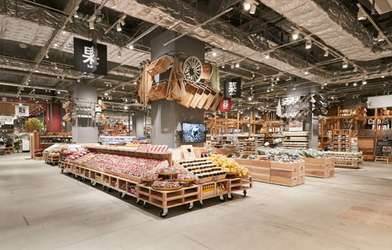
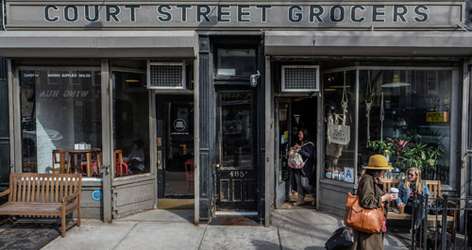


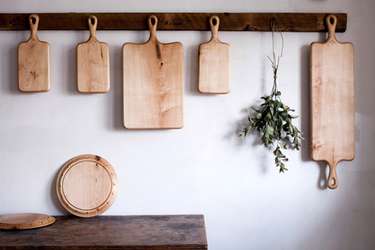

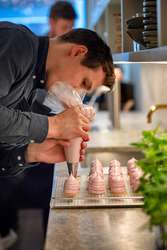
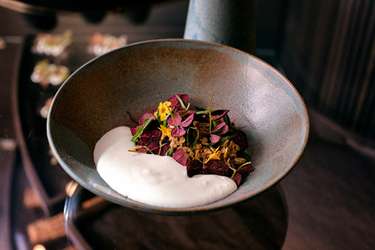
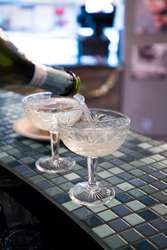
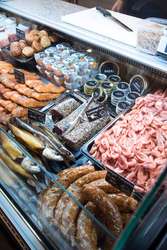
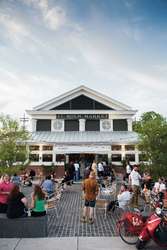
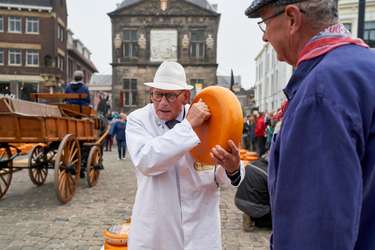

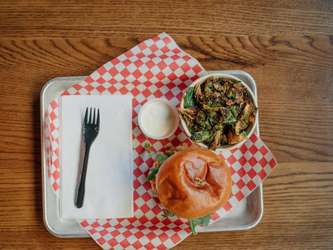
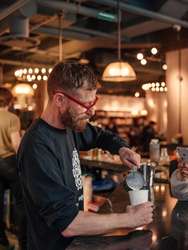


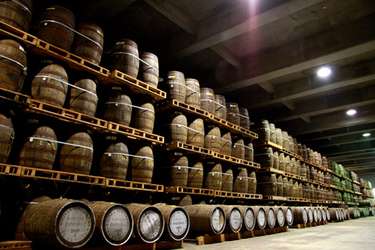
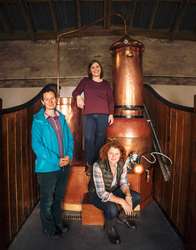
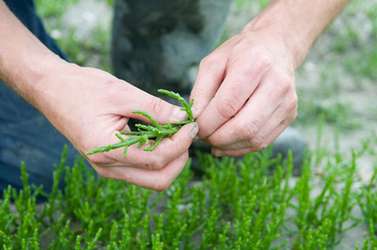
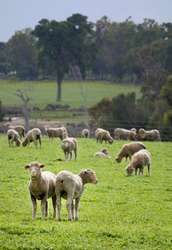
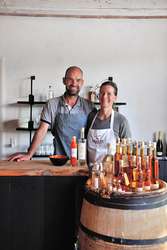


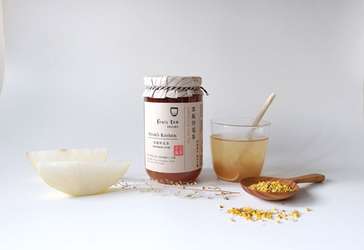
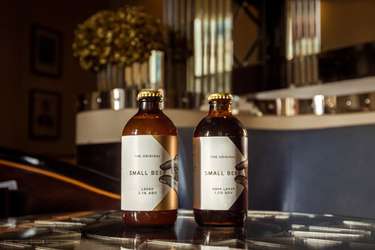
Head over for Aperitivo Hour, which lasts from 19.00 to 21.00 every weekday, to munch dried dates stuffed with tangy gorgonzola and spicy salami, and fried risotto balls filled with mushrooms and truffle oil. The snacks are almost as tasty as New York design firm AvroKO’s handsome fit-out.
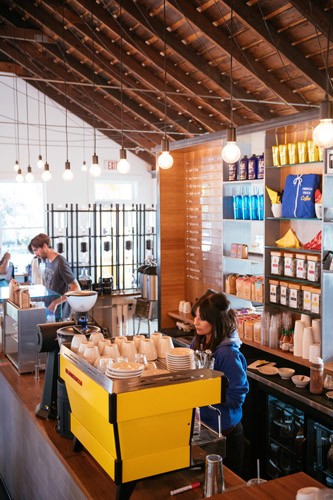
Service with a smile
French Truck Coffee
Louisiana
The coffee scene has perked up in Louisiana of late thanks to openings such as Lighthouse Coffee in Baton Rouge and Lafayette’s Rêve Coffee. But New Orleans’ French Truck Coffee remains the gold standard. Housed in two narrow, bright-yellow houses on Dryades Street, the company launched as a wholesale distributor in 2012 before demand forced owner Geoffrey Meeker to go into retail. Now with five shops across Louisiana and Tennessee, Meeker is drawing coffee fanatics from both states.
Last autumn French Truck Coffee became the first Specialty Coffee Association of America-certified barista-training campus in the region. Meeker’s impact goes beyond serving expertly brewed coffee, however. The secret, he says, is good old-fashioned southern hospitality. “A barista needs to be friendly. If you haven’t got a welcoming person up front, the rest doesn’t matter.”
frenchtruckcoffee.com

Rocking the house
Casa Moro
London
Sam and Samantha Clark, née Clarke, were introduced because of their near-identical names but were brought together by a shared passion for food. The Clarks founded Mediterranean joint Moro, followed by tapas bar Morito. Now they’ve launched catering business Casa Moro alongside a private dining-room space in Hackney Wick. “The type of food we cook at Moro and Morito suits outside catering events, whether it’s a party with delicious mezze or a more formal occasion,” says Sam, whose team has catered big and small events, including Frieze Art Fair, for many years.
moro.co.uk
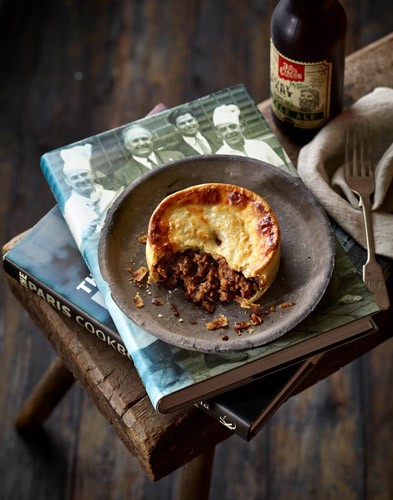
Pie-eating grin
Broomfields PieCycle
Sydney
Ryan Broomfield sells pies from his PieCycle, a vehicle inspired, he says, “by the Flying Pieman William Francis King, who sold pies to Parramatta steamer passengers in the 1850s”. Broomfield, who hails from UK pie-making royalty (his brother Neil founded the Great North Pie Co), launched Broomfields last year and now sells his circular fare in some of Sydney’s best food markets, including the one in the Rocks. Each all-butter pastry pie is made by Broomfield in Balgowlah Heights in Northern Beaches. “The key is working with other small businesses and promoting their produce,” says Broomfield. Classics include a dark ale iteration: local beef is braised for 20 hours in a sauce of ale, blackberry jam and toasted pearl barley.
broomfields-pies.com
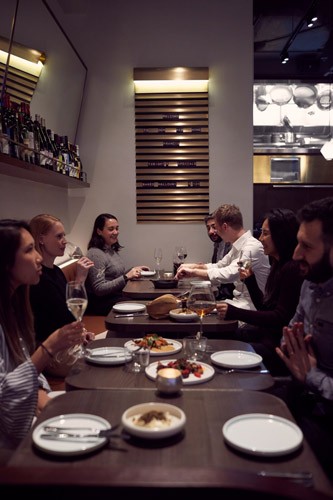
Making a mezze
Francis
Hong Kong
With high rent and initial start-up costs, Hong Kong’s restaurant scene is cutthroat and not particularly forgiving to newcomers. Francis, however, stands out. Just a few steps from monocle’s bureau in Wan Chai, this 30-seat Middle Eastern restaurant has amassed a faithful crowd since opening in early 2018. The reason for its fast-found success – despite the competitive market – is not just its signature mezze, which includes lamb-neck ragu and a simple-but-sterling hummus, but also its service.
“We take care of business ourselves,” says James Ward, who founded Francis alongside Italian sommelier Simone Sammuri and Israeli chef Asher Goldstein. The trio can be found here day and night, Tuesday to Sunday.
francis.com.hk

Royal treatment
Palace
Helsinki
Palace’s reopening in late 2017 was fervently anticipated – and left the venue with a lot to live up to. It originally opened in 1952 and quickly became the stomping ground for Finnish high society, as well as being one of the few Finnish restaurants being talked about abroad. The iconic space closed in 2016 and its Alvar Aalto-designed interiors were auctioned off. Hans Välimäki, however, saw an opportunity.
The Helsinki restaurant scene had become overrun by casual New Nordic fare. As Välimäki – the founder of Chez Dominique, Finland’s first and only two-Michelin-star restaurant – saw it, the time was ripe for a return to fine dining. “Palace focuses on finding the best seasonal ingredients, which are not always local in a country that is frozen in the winter”, says Välimäki, Palace’s chef de cuisine. The food here is unmistakably Finnish but with plenty of international flavour. Välimäki has no plans to serve insects, though, and you won’t find him foraging for wild herbs any time soon. He once proclaimed that he’s a chef, “not a horticulturalist”.
In the kitchen, however, head chef Eero Vottonen puts together perfectly poached eggs served with a soup made from wild Swedish garlic, with a side of pickled onions and sour cream. The main course, meanwhile, is cod glazed with chicken fat that’s served with fresh Italian artichokes and poached lobster with lemon and dill.
Välimäki does not hide the fact that Palace is aiming for top clients paying top krone. The goal is to take Palace back to its roots: the flag-bearer of Finnish fine dining. “Reopening such a classic, it’s the only way to go,” he says.
To pay homage to the restaurant’s heritage, Välimäki enlisted the help of Sweden’s Note Design Studio. Dreamt up by interior architect My Degerth, Palace’s interior oozes warmth thanks to its muted palette combined with mid-century modern furniture. “We wanted to create an atmosphere that honours and highlights what Palace was in its glory days but also transports it to the world as it is today,” says Degerth. “Palace is an icon and its architecture should be highlighted, not hidden.”
palacerestaurant.fi
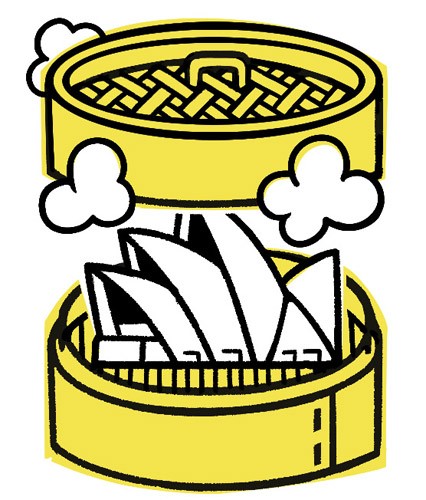
Chowing down
Queen Chow Manly
Sydney
From their fine diner Mr Wong to the easier-going Queen Chow, the Merivale Group turns out some of Sydney’s best Cantonese food. Alongside dumpling dab hand Eric Koh, executive chef Patrick Friesen recently converted Merivale’s popular waterside diner Papi Chulo in Manly into a second outpost of its dim-sum spot Queen Chow. It’s positioned on Manly Wharf with views out to sea and from the cbd it’s just a sparkling 30-minute ferry jaunt across Sydney Harbour.
Popular with groups and families for Sunday brunch, the modern Cantonese menu comprises roast duck, freshly caught seafood and dumplings. The latter include Koh’s famous shu mai: one stuffed with pork and prawns, another with vegetables and black caviar.
merivale.com/queenchow

Mix and match
Whitegrass
Singapore
Australian chef-owner Sam Aisbett used the experience he gained working at Sydney restaurants Quay and Tetsuya to assemble the menu at Whitegrass. Aussie ingredients such as muntries (a type of cranberry), desert lime and fennel pollen from the Blue Mountains are skillfully combined with Asian produce and Japanese techniques to create a delectable array of flavours.
Said flavours are perfectly encapsulated in the smoked-eel salad with rosella jam and Australian mountain pepper, as well as Aisbett’s charcoal-roasted Scottish beef patted in 20-year aged Japanese soya and served with black salsify, wasabi leaf and fermented mushrooms. The menu, which ranges from two to eight courses, is complemented by this 70-seat restaurant’s 19th-century neo-classical setting and playful interior, which comes courtesy of design firm Takenouchi Webb.
whitegrass.com.sg
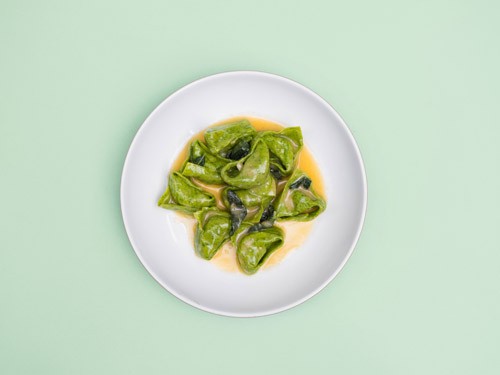
Blast from the pasta
Lina Stores
London
A homesick Italian’s map of London rarely forgoes 18 Brewer Street. It’s here that deli Lina Stores opened almost 75 years ago and where produce from the bel paese can be purchased. Soon there’ll be a new addition to your address book too: the deli is launching its own restaurant nearby. Head chef Masha Rener was a customer of Lina’s during her London youth, before moving back to Umbria to open a restaurant. Her return to the UK has seen her put together a menu that extends beyond her home in Italy to include dishes such as seaside-inspired spaghetti with baby clams and botargo.
linastores.co.uk
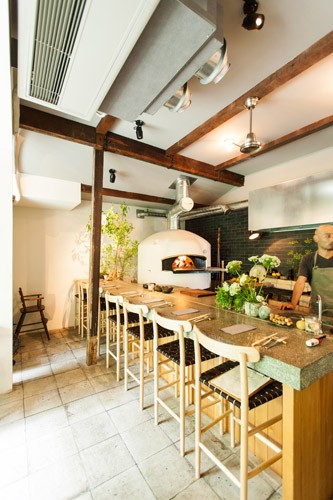
Religious experience
Monk
Kyoto
Set on Philosopher’s Walk, towards Ginkaku-ji Temple, Monk serves inventive contemporary cuisine using local ingredients. A master of wood-fire cooking, owner-chef Yoshihiro Imai starts every morning by visiting farms in Ohara for fresh vegetables, herbs and flowers. The counter seats in his cosy restaurant are very much in demand for their views of him dishing out delicious roasted vegetables, venison and stellar pizza. For that reason and more, reservations are highly recommended.
restaurant-monk.com
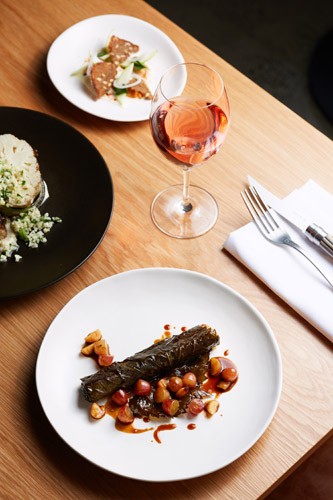
Welcome addition
Messer Fitzroy
Melbourne
“The idea was to create somewhere that everyone felt welcome,” says Ashley Davis (pictured), who along with wife Janine recently opened Messer, a 50-seat restaurant in Melbourne’s inner-north. Situated on the ground floor of a newly constructed apartment block, Messer and its food draws heavily on the couple’s travels in Europe. At lunchtime waiters glide through the understated dining room carrying pork-hock rolls, cauliflower salads and cottage pies. Dinner, which includes wood-fired flammkuchen, is equally impressive and showcases the skills that Ashley picked up on his travels.
Prior to starting Messer, Ashley cooked in some of London’s most prestigious kitchens, such as that of Hélène Darroze. “I have an eye for detail,” he says. “At the same time though, I want Messer to be relaxed and inviting.”
messerfitzroy.com
Pitch perfect
dEFINED BY A STRONG SALES PITCH AND A PASSION FOR STOCKING PANTRIES, THERE ARE THE RETAILERS WE RECCOMEND VISISTIGN IN 2018.
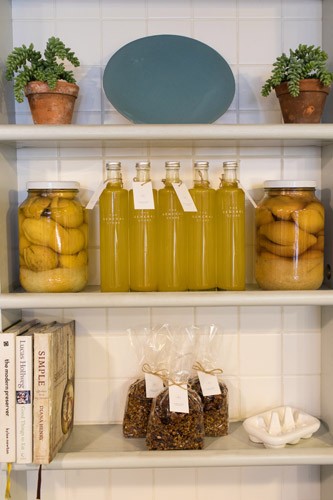
Small wonder
The General Store
Cape town
Tucked between soaring buildings on Cape Town’s bustling lower Bree Street, this tiny timber-clad restaurant and grocer is little more than a nook. The easiest way to spot the General Store, in fact, is to look out for the hungry lunch crowd spilling out onto the pavement outside.
Owned and run by chef Colette Robert, the General Store serves coffee and daily dishes (among its many delectable plates is roasted squash with shaved red cabbage and lime) and stocks a small selection of speciality pantry provisions, including zesty cordials, cookies, granola and preserves.
Stay for lunch or grab a freshly brewed coffee – all of which are served in ceramics designed by local maker Mervyn Gers – and a slice of the fresh-out-of-the-oven cake of the day. Our favourite is the chocolate cake with vanilla-bean frosting and ganache.
the-generalstore.co.za

Dutch ovens
De Pasteibakkerij
Amsterdam
If you chance upon some tasty Dutch-made pâté, terrine or rillettes in Amsterdam, there’s a good chance it was made by De Pasteibakkerij. Hidden away in the back streets of the city’s south, this is the go-to place for charcuterie, a forgotten tradition that owners Floris Brester and Diny Schouten (pictured) are on a mission to revive.
Using free-range grain-fed Dutch pigs, as well as other animals such as geese, they turn the animal’s unwanted parts – the throat, kidneys and so on – into everything from black pudding to pâté, laced with jenever (Dutch gin) and juniper berries. The small shop is only open on Fridays and Saturdays but it’s worth making the effort. They also sell natural wine, fresh eggs and good bread. It’s picnic time.
depasteibakkerij.nl

Self-preservation society
Paul Rothe & Son
London
Originally offering imported goods to cater for London’s German community in the early 1900s, Paul Rothe & Son later moved its cured meats aside and added indoor seating to allow for take-home or sit-down dining. Leap forward to the present day and the look and the feel of the establishment has been well preserved by dint of its fourth generation of family management.
It’s located on Marylebone Lane just a short jaunt from Midori House and the walls, shelves and window displays here are neatly stacked with jars of heat-treated fruit, vegetables and spices. Each one is charmingly packaged with calligraphic labels and a cloth-sealed cap, making it difficult not to leave with a selection after scoffing your sandwich. It’s got more than a century of service under its belt; preservation seems to lead to an exceptionally long shelf life.
+44 (0)20 7935 6783
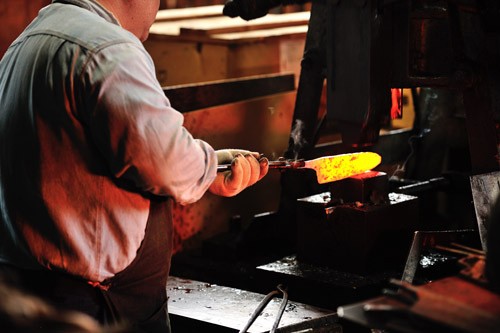
A cut above
Tadafusa
Niigata, Japan
When Tadafusa ceo and third-generation Japanese knife-maker Tadayuki Sone decided to rebrand the family business in 2012, he never imagined that his knives would end up as design classics in New York’s Moma. He has been producing blades since 1948. “Our main clients were fishermen when our business almost went bankrupt in 2011; the earthquake put many out of business,” says Tadayuki. “It was time for a change.”
He asked Fumie Shibata from Japan’s Design Studio S for help. The result was the Hocho Kobo collection: a set of more contemporary knives.
Meanwhile, interior designer Yusuke Seki restyled the showroom next to the old factory in Tsubame-Sanjo, in Niigata prefecture. The shop’s light, quiet interior made from carbonised pinewood – also used in some of the knife handles – makes for an interesting contrast to the noisy factory next door, where 15 craftsmen always seem to be at work. Tomoji Sone, Tadayuki’s uncle, has been practising the craft of knife-making for more than 50 years, though today his work is appreciated not only by local fishermen but by chefs and enthusiasts around the world.
tadafusa.com
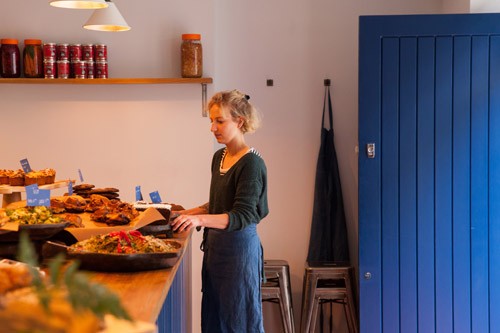
Get baked
Fortitude Bakehouse
London
A new venture from baker Dee Rettali and London café veteran Jorge Fernandez (both pictured, below right), formerly of Monmouth Coffee Company, Fortitude Bakehouse is based in an old stable and is the first bakery in the capital to focus exclusively on sourdough cakes, with gluten-free bakes to boot.
Choose from superb seeded loafs and unusual treats such as buckwheat and vanilla-cream biscuits and apple and thyme crumble with chestnut flour. An open kitchen reveals the bakers hard at work and Rettali plans to hold regular workshops on sourdough baking, slow fermenting and cooking with alternatives to regular wheat flour. The spot is all about takeaways but also has a small counter for those wishing to sit and savour their treats indoors.
fortitudebakehouse.com

Unbeatable meat
Cure Deli
Cape town
Born in founder Martin Raubenheimer’s parent’s garage, Cure Deli has never been (and still isn’t) your typical food retailer. The brand began as a project to promote ethical meat consumption by scrupulously working with farmers who rear their animals with traceable origins. Cure Deli buys whole carcasses then prepares a selection of products, including bangers, bacon and grass-fed lamb.
To avoid “manipulative middle-man meat merchants and dodgy distributors”, as Raubenheimer calls them, devotees place their orders online and wait to receive a delivery, or collect their products from Cape Town’s Oranjezicht City Farm Market or Earth Fair Market. “We believe this makes us unique,” says Raubenheimer. “We have never compromised on our commitment to offer an alternative to indiscriminate mass consumerism.”
curedeli.co.za
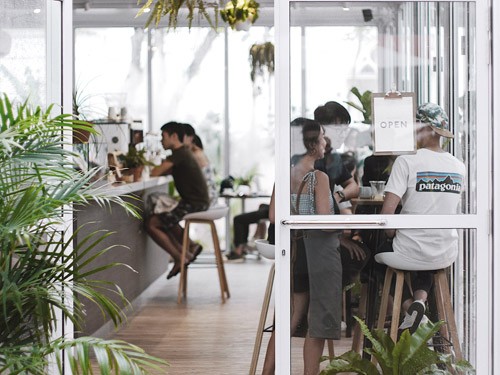
Sweetness and light
The Glasshouse
Singapore
At the Glasshouse, natural light streams in through the custom-built glass pavilion and onto greenery styled by botanical artist Charles Loh of Singapore-based Mossingarden. Founders Josh Liew and Qing He have stitched together a showcase of Singapore’s best producers, proving that what the city lacks in resources it makes up for with its rich stock of makers and food entrepreneurs.
The 25-seat café serves a range of brews made from blends by local roasters including Common Man Coffee and Homeground, which pair perfectly with its sweet pastries and open-faced sandwiches made with bread by Woodlands Sourdough. A corner of the space is dedicated to handcrafted treats such as bean-to-bar single-origin goodies by Fossa Chocolate and scented candles by Marcantile.
+65 9793 0234
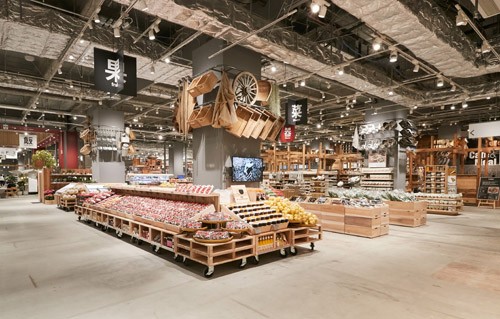
Connecting people
Muji Marche
Osaka
When Muji’s spruced-up Tokyo flagship store reopened last year a new element was introduced: Muji Marché, a fruit-and-vegetable market selling low or no-pesticide produce from Japanese farms. Now Muji has pushed the concept further with a giant new shop and café outside Osaka.
The world’s biggest Muji incorporates a spacious food shop that sells seasonal fruit and vegetables, Wagyu from Miyajima and fish from two nearby ports. Muji’s mission is to connect city dwellers with the people who make their food; anyone who wants to test the quality of the produce should go to the café, where a daily menu features anything from fresh sushi to Japanese croquettes.
muji.com
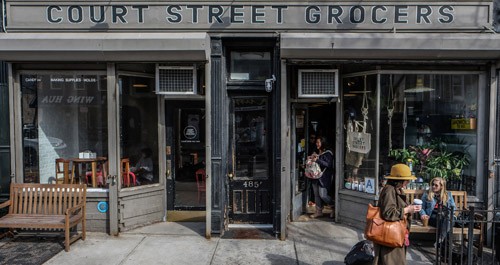
Local commodities
Court Street Grocers
New York
In need of speciality soda, French salt, upstate yogurt or California olive oil? Court Street Grocers is an excellent stop-off in this regard. The product-packed grocer has been fuelling Carroll Gardens’ residents with homemade sandwiches for years but its prowess doesn’t end there: locals comes for cult products that can be hard to find elsewhere.
You can nab everything from regional cheese and bread to sweet treats or freshly roasted and ground beans for filter coffee (you’ll find no flat whites here) at this no-frills shop. But don’t leave without sampling one of Court Streets’ iconic sandwiches. The Reuben, with its house-corned short rib beef, Swiss cheese and sauerkraut on rye, has rightfully helped cement the status of this low-key joint into that of a neighbourhood institution.
courtstreetgrocers.com

Got wood
Blackcreek M&T Co
New York
After an eight-year hiatus from furniture-making, Joshua Vogel of bddw fame founded Blackcreek Mercantile & Trading Co in 2010 with partner Kelly Zaneto. The smart studio has since grown to 12 employees, who collaborate to produce exquisite maple chopping boards and kitchen utensils. One of Blackcreek’s most unique pieces is its line of maple salad bowls made from free-form turnings, a lengthy process that means they’re only available once a year. Luckily the Hudson Valley isn’t your only option for buying Blackcreek wares: there are a handful of stockists around the globe.
blackcreekmt.com
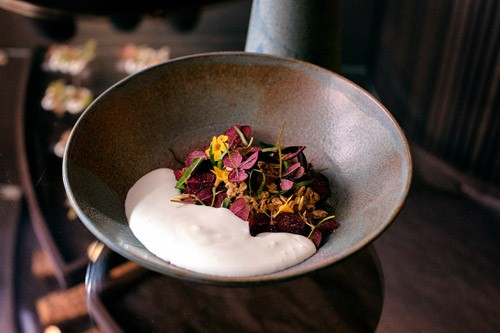
Just desserts
Winterspring
Copenhagen
Chilly desserts don’t come more refreshing than Winterspring’s, whose unmatched flavours are informed by the likes of wild raspberries, sun-ripened apples and Italian liquorice. “We have always taken pride in combining Nordic flavours with innovative techniques to create exquisite desserts,” says founder Karina Schmitt Lund. Now Winterspring has opened its own dessert bar, which also serves breakfast, lunch and afternoon tea. The space was decked out by the smart souls at Studioilse: think Swedish ceramics and embroidered linens. Meanwhile, a purpose-made walnut-and-curved-glass vitrine shows off Winterspring’s take on Danish flødebolle (chocolate-covered marshmallows).
winterspringdesserts.com
Making a mark
For those whose hunger is a little harder to satisfy, you’ll find options aplenty in our round-up of recommended markets.
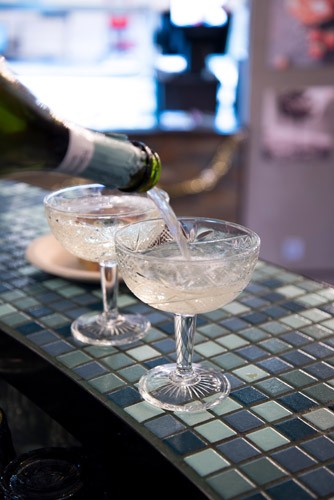
Centre of everything
Central Food Market
Aarhus
The food scene in Aarhus is so far ahead of similarly sized cities that it’s only natural that its markets make for excellent eating. Central Food Market may be less fancy than the city’s ritzy restaurants but its lively environment – a dark interior peppered with long black-lacquered tables – makes for a dramatic setting. Enjoy breakfast at Grød, which serves oatmeal and congee with sweet (caramel, almonds) and savoury (scallions, sesame) toppings. Then lunch at Bangkoch, where diners can enjoy Asian streetfood with a Nordic nudge courtesy of chef Jesper Koch.
aarhuscentralfoodmarket.dk

All jazzed up
St Roch Market
New Orleans
Many fail to acknowledge that New Orleans’ food culture goes beyond po’boys, gumbo and grits. At Nola’s St Roch Market, tacos, shakshuka, oysters, crawfish – as crayfish is known in these parts – and craft coffee sit side by side. Vendors that include Elysian Oyster Bar, Fete Au Fete (classic Cajun cuisine) and Good Bird (rotisserie chicken sandwiches and salads) showcase fare from all over the globe.
Weekends are when this market really gets grooving. It’s when families enjoy long lunches and young New Orleanians quaff cocktails from the Mayhaw Bar while tapping their toes to live jazz.
neworleans.strochmarket.com

Indecent proposal
Queen Victoria Market
Melbourne
Queen Victoria Market holds a special place in local hearts – and stomachs. That’s why a Melbourne council redevelopment plan is proving hard to swallow. The proposal has been blocked by Heritage Victoria, which believes that renovating the market would sever it from its roots. The setback comes after the proposal’s political architect Robert Doyle stepped down as mayor. His replacement will have to come up with some fresh ideas for the ageing monument, irrespective of which side of the debate they’re on.
qvm.com.au
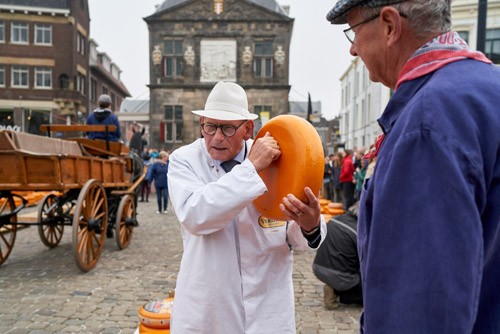
Say cheese
Cheese market
Netherlands
Every Thursday morning between April and August, visitors flock to the city of Gouda to catch its cheese market, which has been held every year since 1395. Farmers from the surrounding region are responsible for producing 60 per cent of all Dutch cheese and Gouda has long been the best place for them to show off their artistry.
goudakaasstad.nl
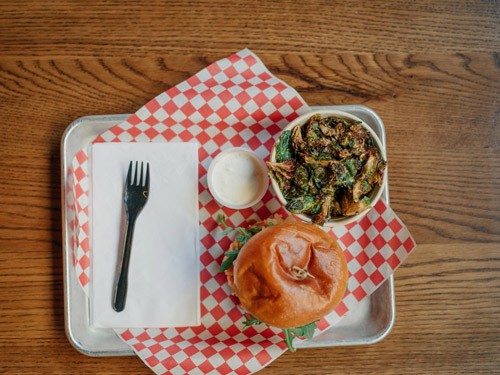
Under one roof
Assembly Chef’s Hall
Toronto
Canada’s largest city has caught up with the rest of the world with the advent of its new food court, the rather smart Assembly Chef’s Hall. “Offering something for everyone was critical,” says restaurateur Andreas Antoniou over the din of the lunch crowd at the market on Richmond Street in downtown, which he opened in the base of one of the area’s myriad corporate tower blocks in January.
On busy weekday lunchtimes, chefs at Bluenose Lobster pop soft pieces of the shellfish into the restaurant’s signature roll; nearby, servers at Tachi wait to seat diners at Canada’s first standing-only sushi restaurant. Down the hall, chefs at The Good Son Pizza slide freshly topped crusts into the oven and the cooks at Love Chix dress glistening pieces of freshly fried chicken for a patient line of hungry customers standing at the counter.
assemblychefshall.com
Humble origins
Provenance may have become a go-to culinary buzzword but that doesn’t make it any less important. Here we explore distilleries in unexpected spots, find out why lamb-lovers are flocking to Western Australia’s best restaurants and take in the verdant glow of the Zeeland region to meet those coming up with the goods.
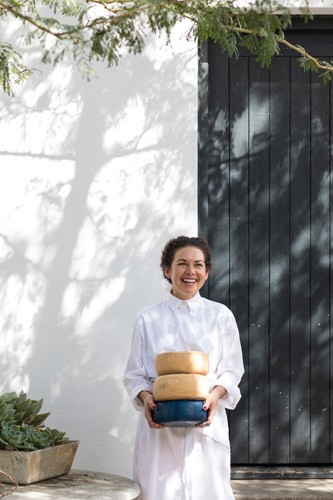
Milking it
Gay’s Guernsey Dairy
Klein Karoo, South Africa
It was a simple demand for fresh milk that made Gay Van Hasselt start a dairy. She and her three cows began providing fresh milk for the town of Prince Albert in South Africa’s arid Klein Karoo region about 30 years ago. Today Van Hasselt also produces yogurt and cheese made from full-fat cream and raw Guernsey cow’s milk. Her products are available at delis around the region but many make the four-hour trek from Cape Town just to get their hands on her sharp-tasting matured cheddar and parmesan-style Parma Prince cheese.
gaysguernseydairy.com

Cask away
Kavalan Whisky
Yuanshan, Taiwan
When Taiwan joined the World Trade Organization in 2002 and its government lifted the monopoly rights on alcohol production, Lee Tien-Tsai, head of the nation’s leading beverage firm King Car Group, began gathering resources to set up the country’s first whiskey distillery. Today the brand is an Asian alternative to Japan’s Nikka and Suntory, selling in 68 countries.
kavalanwhisky.com
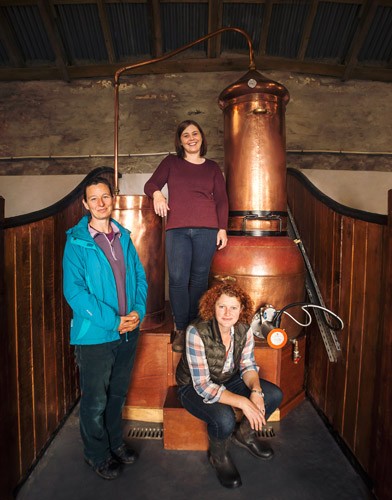
Sea change
Lussa Gin
Jura, Scotland
Windswept and bleakly beautiful, Jura on Scotland’s west coast is perhaps best known for its whisky distillery of the same name. Follow its only road – a potholed single track – for a further 27km north, however, and you’ll reach the stables of deer-stalking estate Ardlussa, the home of Lussa Gin.
It’s 205 years younger than its whisky-producing rival but the island’s 200 residents should be no less proud of the tipple that this outfit has been turning out since 2015. Lussa Gin brings together spring water, neutral spirit and 15 botanicals (many grown and foraged on and around the island, including sea lettuce and Scots pine). With fresh citrus and forest notes and hints of the sea, the result is a dangerously delicious combination. Critics agree: there is a growing number of awards piling up in this remote but remarkable distillery.
Lussagin.com

Coast with the most
Zeeuws Zilt
Zeeland, The Netherlands
When Hubrecht and Maarten Jansa’s grandfather bought a plot of coastal land in the Netherlands’ sun-drenched Zeeland region in the 1970s, he worked hard to replace the native samphire and sea lavender with potatoes and wheat. Today the Jansa brothers are returning to their salty roots, using the region’s nutrition-packed natural bounty to make unusual products such as gin, cheese and seaweed mustard.
Visitors to the family business’s shop in Wolphaartsdijk can camp on site and visit the samphire fields, which turn a verdant green between May and September.
zeeuwszilt.com
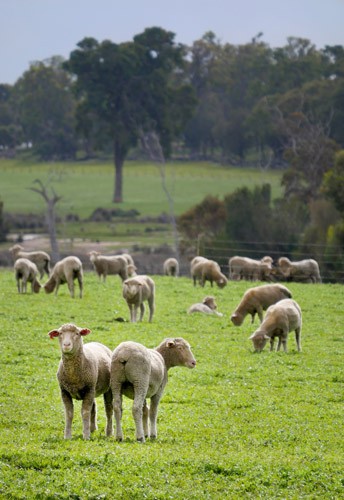
On the lamb
The Farm House
Western Australia
Visit a top Western Australian restaurant such as Wildflower in Perth or Voyager Estate in Margaret River and the chances are that you’ll see Arkady Lamb on the menu. This flock of 15,000 Wiltshire ewes bred on Lynford Farm, a two-hour drive southeast of Perth, is synonymous with premium lamb (and diners here know their lamb).
Most Australian sheep are bred firstly for wool and secondly for meat; not so the Arkady flock. The sheep are co-owned by third-generation farmer Colin Houghton and farmer, winemaker David Hohnen. Together the duo focus on minimising the animals’ stress: there are no dogs on the farm and the lambs are left to roam, monitored not by barks but by (gentle, we’re told) electronic ear tags.
thefarmhousemr.com.au
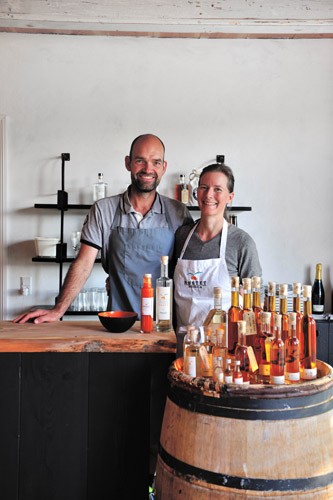
Bucking the trend
Høstet
Bornholm, Denmark
Camilla and Mads Meisner (both pictured) never set out to become sea-buckthorn farmers – but then, who would? Following a holiday on the Danish island of Bornholm, the couple decided to decamp from their home in Copenhagen to the Baltic island permanently. “I was taking a course in superfoods and became aware of sea buckthorn, which is a plant that’s been around since the last ice age,” says Camilla.
After realising that no one was growing the shrub commercially in Denmark, the couple began harvesting its bright orange berries, which are extremely high in antioxidants. Their first product was marmalade, a creamy sweet-and-sour jam that won first place at a recent Bornholm food fair. “All of our products are artisan-style and not big scale yet,” says Camilla. Today they sell their organic products in select delis and tasteful restaurants.
hoestet.dk
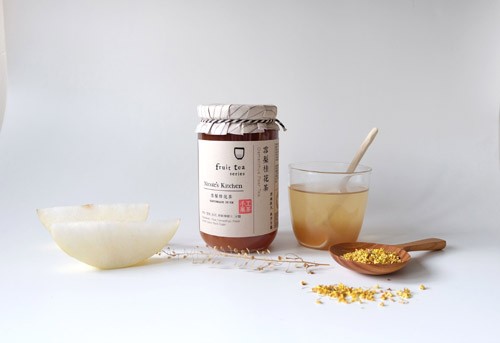
On the sauce
Nicole’s Kitchen
Hong Kong
Nicole’s Kitchen began seven years ago when mother of two Nicole Wong began making fruit jam for her children and friends. The Hong Kong business may now sell more than 100,000 jars a year but Wong preserves the flavours of home cooking by forgoing artificial additives, which helped persuade retailers to stock her products back in 2015.
She has since expanded the line-up to comprise some of the most popular Cantonese condiments, including xo sauce and black-bean-and-garlic chilli sauce.
nicoleskitchen.com.hk
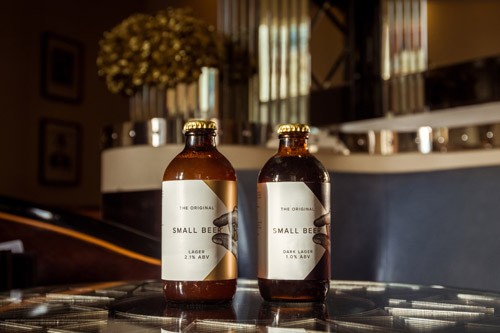
Sweating the small stuff
Small Beer Brew Company
London
Before the 19th century’s advances in sanitation, a glug of contaminated water could have had a seriously nasty outcome. Low-alcohol and so-called “small beer”, therefore, was the norm in homes and even schools. But the need for small beer eventually ebbed away and its recipe was lost. Until now.
Brewers Felix James and James Grundy have pored over history books and ancient recipes to open the world’s first small-beer brewery in southeast London’s Bermondsey. Their low-alcohol dark and light lagers might come in small bottles but they’re big on flavour. Their manifesto? “Historically, small beer was considered an afterthought when brewing but we believe this should never be the case. Using sustainable brewing methods, we are committed to reinvigorating a liquid that was once at the very heart of society.”
theoriginalsmallbeer.com
Crafty collaboration
Suntory, Roku Gin
Osaka
In the 82 years since Suntory released Hermes, the first “Made in Japan” gin, the Osaka-based company has accumulated distilling know-how aplenty. Now, after specialists spent a year at the Suntory liquor studio in Osaka, the brand has created a craft gin that blends six (roku) Japanese botanicals, including gyokuro tea and citrusy yuzu. Beam Suntory then helped to create the branding for the global market; the hexagonal bottle bears a washi paper label with no-nonsense roku lettering by calligrapher Tansetsu Ogino.
suntory.co.jp


